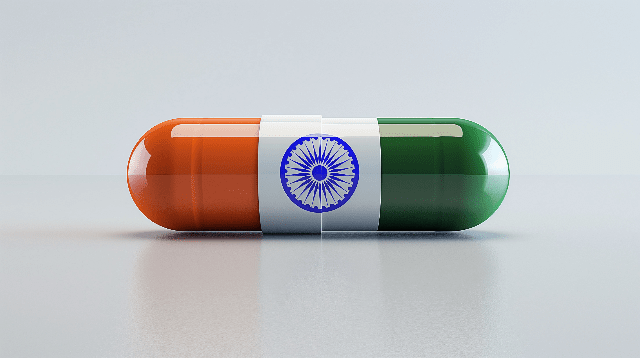Reflets Magazine #153 | India: The World’s Biggest Pharma
In Reflets Magazine #153, Vishal Kanojiya (M15), Senior Manager Exports Supply Chain at Sanofi in Mumbai, and Manu Bharath Harish (E15), Senior Manager at Akshaya Enterprises in Mysuru, explain why India is considered the “Pharmacy of the World”. Here is a free online version of his interview… Subscribe to get the next issues (in French)!
Reflets Magazine: How is the pharmaceuticals sector faring in India today?
Vishal Kanojiya: The pharmaceutical sector is expected to touch USD 130 bn in 2030 from USD 50 bn in 2020-21 with exports surpassing USD 65 bn. Exports account for 20% of global pharmaceutical supply volumes and more than 60% of the global vaccines volumes.
Manu Bharath Harish: Another interesting metric is that the pharmaceutical stocks have largely outperformed the larger stock market index.
V. Kanojiya: On the flipside, market has also witnessed either complete exits or trim downs from Big Pharma due to intense competition from generic companies once their drugs go off-patent.
M. B. Harish: That being said, overall sales have seen a steady growth with new local pharmaceutical and nutraceuticals companies slowly getting a larger share of the market – such as Amrit Noni, an ayurvedic (traditional Indian medicine) company’s that now has sales larger than Pfizer Ltd.
RM: What are the major strengths of India’s pharmaceuticals sector?
V. Kanojiya: Our mix of low-cost manufacturing and high talent capital allows us to combine agility and quality: outside the United States, India has the highest number of US-FDA approved plants across the world.
M. B. Harish: We also have an optimal supply chain with many local producers of pharmaceutical ingredients, contract facilities that can manage seasonal demand for medicines, and an extensive distribution network for last-mile deliveries, including cold chains, even to very interior regions.
RM: And what are India’s pharmaceuticals sector’s weaknesses?
M. B. Harish: Some storage and handling infrastructures are not compliant. Illegal exports of painkillers and insulin are another hindrance.
V. Kanojiya: We also struggle to find the right balance between keeping the drugs affordable and safeguarding innovation through patents and exclusivities, which often delays the launch of new medicines. Some other challenges are limited R&D infrastructures and investments, and gaps in regulatory oversight as against high number of plants.
RM: What about the difficulties and inequalities faced by the Indian population in accessing medicines?
V. Kanojiya: The situation has changed tremendously as of late. The government scheme 'Pradhan Mantri Bhartiya Janaushadhi Pariyojana' (PMBJP), which subsidizes medicine shops, is projected to expand from 10,000 stores in 2024 to more than 25,000 eventually. The 'Pradhan Mantri Jan Aushadhi Yojana' (PMJAY) scheme, which provides insurance to the needy for approximately USD 6,000 per family, has been hailed as the world's largest government-funded health plan, covering more than 550 million individuals.
M. B. Harish: Also, one can get vaccines and treatments for free through government run hospitals, make doctors’ and labs’ appointments in a few minutes through several apps, and have medicines delivered on the same day. Not to mention the backend tech infrastructure to man age contagious diseases such as tuberculosis, which is better than in any other country. Hence polio and several other illnesses are now completely eliminated, and bird flu, Nipah, and other outbreaks are swiftly contained.
RM: There have also been concerns about the safety and counterfeiting of medicines in India…
V. Kanojiya: Indeed, there have been unfortunate episodes of deaths from adulterated syrups, and infections and vision losses from microbial growth in eye drops and ointments, mostly linked to under-investigation efforts on customer complaints, sanitary-cum-cleanliness aspects and data integrity. In response, Indian regulators have geared up with their controls, inspecting 162 pharmaceutical sites of which 143 have been issued show cause notices and 40 have been asked to cease production. Furthermore, a government lab has been established to test the quality of syrups and issue Certificate of Analysis before exporting.
M. B. Harish: I can’t help but point out that such news make it to international press, while concerns about Johnson & Johnson and Pfizer’s COVID vaccines rarely do. Yet, the Indian government disallowed those, as the labs did not comply with the Health Ministry’s request for it to be tested on Indian population, and immunity was not granted to these companies against lawsuits that may come due to adverse effects.
RM: What actions is India taking to support the growth of its pharmaceuticals sector?
M. B. Harish: The stamina of the Health Ministry against lobbies (so far) and the growing powers of the drug control department, combined with a sophisticated tech infrastructure seems to be taking us in a good direction.
V. Kanojiya: The Indian government has launched a 'Production Linked Incentive (PLI)' scheme with a budget of about USD 834 mn to bolster domestic manufacturing of 41 critical pharmaceutical ingredients by 2029-30. It has also announced additional PLIs for medical devices setups. The sub-sector has already seen foreign direct investments double to USD 3.4 mn within the first 9 months of 2023, and the market is expected to grow from USD 8 bn in 2021 to more than USD 20 bn by 2027.
RM: What are the prospects for India’s pharmaceuticals sector in the years ahead?
M. B. Harish: The market capitalization and growth of our homegrown companies make me confident that they will compete even stronger in the international markets in the years to come.
V. Kanojiya: The next leap for them though is to develop a niche position not only as a mass-scale producer but also an innovator. As of now, Indian companies invest only about 1.5% of their sales revenue into R&D programs versus an average of 2.5% by foreign players. They need to invest fervently in R&D initiatives and establishments within the country, with the government’s support.
Interview by Louis Armengaud Wurmser (E10), Content Manager at ESSEC Alumni
From Reflets ESSEC Magazine #153. Read a preview. Subscribe to get next issues (in French).
Image : © AdobeStock

Commentaires0
Veuillez vous connecter pour lire ou ajouter un commentaire
Articles suggérés



